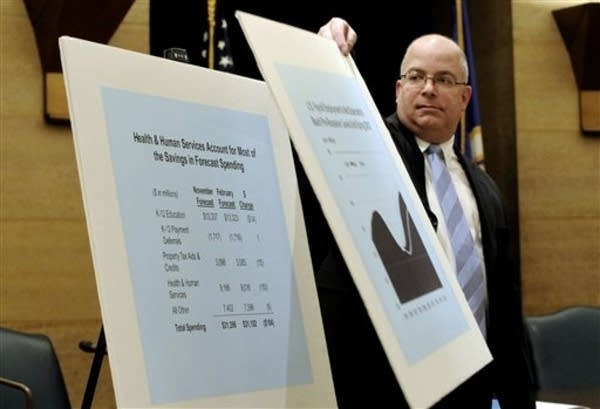Minn.'s line of credit will cost state $1.6M or more
[image]
The line of credit Gov. Tim Pawlenty's administration set up to keep Minnesota from running short of cash will cost the state nearly $1.6 million even if it's never used, documents obtained by The Associated Press show.
State leaders signed off last week on the $600 million line from four lenders led by Minneapolis-based U.S. Bank. Finance officials say it's a necessary protection as Minnesota's cash sinks to worrisome lows.
The credit line could wind up costing more if the state has to borrow any or all of the money, but finance officials wouldn't offer any estimate of how much. Similar to a home equity loan, a credit line's full cost depends on how much is borrowed and what interest rates are when it's tapped.
Create a More Connected Minnesota
MPR News is your trusted resource for the news you need. With your support, MPR News brings accessible, courageous journalism and authentic conversation to everyone - free of paywalls and barriers. Your gift makes a difference.
Details of the state's arrangement had been kept confidential, but AP obtained legal documents, charts and other correspondence related to the deal through a public records request.
Democrats have blamed Pawlenty's long-standing opposition to tax increases for the state's dwindling cash balance. The Republican governor has maintained the state's tax burden and spending are too high, and the cash flow difficulty is due largely to the recession.
Among the credit line documents was a covenant signed by Pawlenty pledging Minnesota's taxing authority as collateral, meaning that in a worst-case scenario the state would have to raise property taxes to make good on what it owes.
The state already has paid the banks $635,000 to set up the fund and will face $937,000 in fees if it doesn't use the money before the contract expires next summer. The state also expects to pay roughly $100,000 to a finance consultant who helped vet proposals for the credit line.

Minnesota hasn't resorted to short-term borrowing since 1984. While it has a balanced budget now - and is expected to end the next fiscal year with a positive balance - the state doesn't always collect and spend dollars at the same rate.
The goal is to keep the general treasury's daily balance above $400 million, but Minnesota officials expect it to start slipping below that in late October. By mid-December, the state's checking account will be at just $109 million.
At that level, Minnesota Management and Budget Commissioner Tom Hanson said Thursday he'd be more likely to tap into the credit line. He said there isn't a certain point at which he would borrow, and he says he hasn't been pressured by Pawlenty - who has attacked Democrats in Washington over federal spending and debt - to avoid it. An AP request for written correspondence between Hanson and Pawlenty's top aides turned up nothing.
Pawlenty leaves office in January and is considering a run for president.
He has downplayed the prospect of having to borrow and Hanson said it's still not a sure thing. Hanson said even if it happens, he "would be very surprised and shocked" if Minnesota draws on the entire $600 million.
More federal health money is due to arrive in Minnesota beginning in January, but emergency aid in response to recent flooding in southern Minnesota could add to the near-term cash strain.
Hanson said the bank line offers the state security and will protect Minnesota's good rating with Wall Street bond houses. Those ratings make it cheaper to borrow money for construction projects.
Pawlenty's budget team has taken other steps to fend off a cash shortage. They have delayed hundreds of millions of dollars more in payments to schools and public universities and have held back tax refunds to businesses. As a result, some school districts have had to pay interest on short-term borrowing of their own.
Senate Finance Committee Chairman Dick Cohen said it all stems from a budget that's been patched together amid Pawlenty's refusal to consider new taxes. The new costs to the state trouble him.
"The size of that, in it of itself, is not huge," said Cohen, a St. Paul Democrat. "On the other hand, we don't have extra money. We could use that $1.6 million in many different and better ways."
Minnesota isn't the only state looking to a bank for a lifeline. Last December, Pennsylvania took out its first short-term loans since 1998 when it borrowed $800 million. A couple of months earlier, Arizona made its first-ever use of short-term notes.
In February, Moody's Investor Service documented $25.8 billion in short-term borrowing by states in the last fiscal year. It was the most in five years, and the firm predicted more of the same into this fiscal year.
Under the Minnesota contract, any debt must be repaid by the end of June. Hanson and his staff raised the possibility the credit line could be terminated early if things look up.
Still, some involved in setting up the credit line appeared to be considering worst-case scenarios.
According to one e-mail exchange, U.S. Bank, the winning bidder, came to the state with a simple question: Whether Minnesota law allows the state to file for bankruptcy. The state, citing an expired deadline for questions from bidders, didn't answer.
"I don't see how it could ever happen in a state like ours," Hanson told AP.
(Copyright 2010 by The Associated Press. All Rights Reserved.)